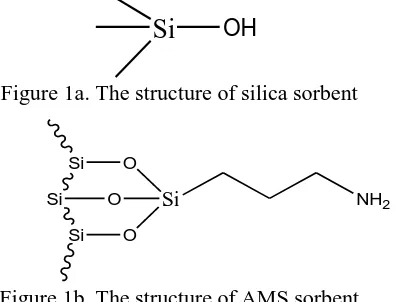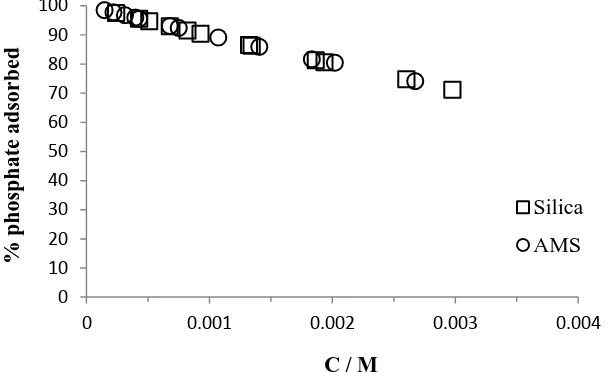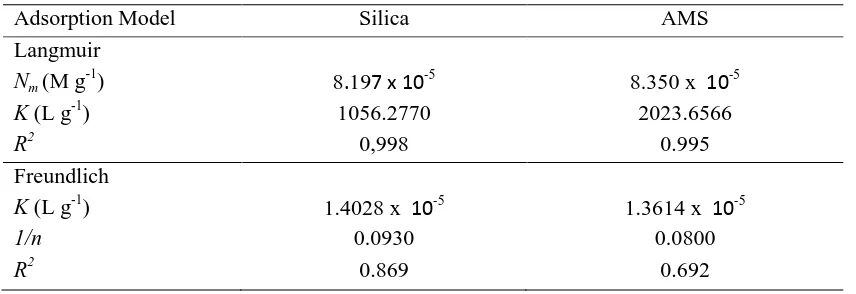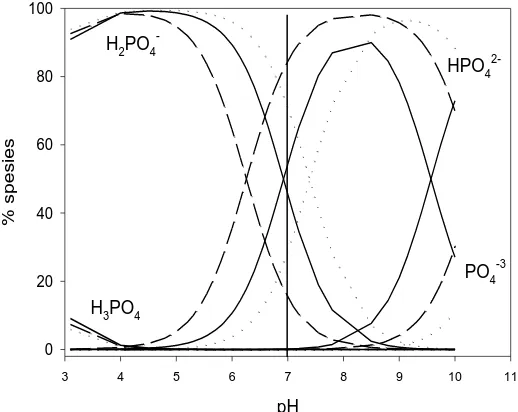Adsorption Isotherm of Phosphate Ions onto Silica
and Amino-modified Silica from Lapindo Mud
Jaslin Ikhsan1,2, Siti Sulastri1, Erfan Priyambodo1
1
Department of Chemistry Education, Faculty of Mathematics and Natural Sciences Yogyakarta State University, Jl. Colombo No. 1 Yogyakarta
2
email: jikhsan@uny.ac.id
Abstract
The study of phosphate adsorption isotherm was carried out to propose the adsorption process. The propose was based on best fit of experimental data to isotherm equation model, and proton stoichiometry (), e.i. the number of protons taken or released by the adsorption process. The isotherm model might show site density of sorbent (Nm) and equilibrium constant for the adsorption process (K). The experimental data were collected by varying concentration of the phosphate ions at a constant pH 7.0 and room temperature on equilibrium time of 1 hour contact to the surfaces of sorbent of silica or amino-modified silica (AMS) from Lapindo mud. Data of proton stoichiometry were collected by noting very carefully the amount of added H+ or OH¯ ions to maintain the pH 7.0 during the contact time of each phosphate concentration studied. Experimental data fitted very well to the Langmuir isotherm equation, indicating the formation of monolayer coverage on available surface sites of both silica and AMS whose Nm of silica was about the same as that of AMS, e.i. 8.197 x 10-5 and 8.350 x 10-5 M g¯1, respectively, but the values of K of the adsorption onto silica was about a half of that onto AMS, e.i. 1056.277 and 2023.657 L g¯1, respectively. Very few values of indicated that adsorption process did not involve proton. From the model, the study suggest that adsorption processes on both silica and AMS were through hydrogen coordination bond.
Keywords: Phosphate adsorption; amino-modified silica; adsorption process; hydrogen coordination bond.
1. Introduction
Phosphate ion is one of micro nutrients that are needed by plants. A lot amount of phosphate ions are used by farmers without stoichiometric calculation. As a result, phosphate excess in significant amount is wasted to flow to river or lake without careful control. Therefore, environmental problems may arise. For instance, many worthless plants thrive in rivers and waterways leading to imbalance of water ecosystems. Therefore, transport of phosphate ions in water is crucial to be investigated and controlled.
Adsorption was commonly used as a process to remove or to decrease the concentration of chemical wastes in the environment. Adsorption was also used to understand the process of transport of molecules or ions in water. By varying the concentration of sorbate in the adsorption experiment, which is known as adsorption isotherm, adsorption process may be predicted. Bono et al. (2014) proposed that pores of the sorbent were essential on binding of acetone and propanol from a non-azeotropic mixture. It was indicated by higher adsorption fraction of sorbate onto activated carbon than onto silicate, due to their different porosity. The adsorption was described by the formation of monolayer type adsorption. Based on fitting to adsorption data by Langmuir equation, Ikhsan et al. (1999) argued that metal ions were bound by clay mineral kaolinite through non-specific electrostatic interactions, with adsorption occurred by ion exchange.
proton stoichiometry values were higher which indicated that surface sites of kaolinite involves the expulsion more proton because of inner-sphere coordination to the sites.
Silica contains hydroxyl groups (OH) which is variable-charged. After it was modified with amine, the active sites were amine groups (NH2). Adsorption isotherm experiments of phosphate ions by both sorbents were modelled by Langmuir or Freundlich Isotherm equation to understand the style of adsorption, site density of sorbent (Nm) and equilibrium constant for the adsorption process (K).
2.
Methods and Experimental DetailsThe sorbent of silica was separated from Lapindo mud, and AMS was amine-modified of the silica from Lapindo mud. Both silica and AMS were adsorbents used in this study.
Adsorption isotherm was conducted to find out the effect of phosphate concentration. The sorbent of silica or AMS was dissolved into 150 mL 0.01 M of KH2SO4 whose pH was adjusted to be 5 and kept constant by adding KOH or HNO3. The suspension was let equilibrate for 2 h, and 10 mL sample was taken. The concentration of KH2SO4 was increased by adding the stock solution of KH2SO4 in steps of increments until the total concentrations added were 0.015 M. On each step of addition of stock solution which reached equilibrium time of 2 h, a sample was taken. The concentration of KOH or HNO3 added for maintaining the pH was recorded carefully. All samples were centrifuged and their filtrates were analysed for free concentration of KH2SO4 using UV-Vis Shimadzu 2450.
Data of adsorption isotherm were analysed by Langmuir or Freundlich isotherm equation to calculate Nm and K.
3. Results and Discussion
The sorbents that were used in this research were (a) silica that were separated from Lapindo mud, and (b) silica from the mud that was modified by amino (AMS). Both sorbents were prepared and being reported in a separate publication.
Si
OHFigure 1a. The structure of silica sorbent
Si
Figure 1b. The structure of AMS sorbent
Adsorption isotherms of phosphate by each adsorbent were measured at pH 5.0. The pH of suspension of sorbent was adjusted into pH 5.0, and so was the pH of phosphate stock solution. Keeping the pH of system be constant was to note the concentration of acid/base that were added in the experiments. The consumption of acid/base in the adsorption was used to estimate the amount of proton that was needed or released when the adsorption take placed, that was called proton stoichiometry, (Table 1). Similar method was done by Ikhsan et al. (1999; 2004a, 2004b) to determine the number of proton that was taken up or released in the adsorption of transition metal ions and aspartic acid by kaolinite.
Table 1 showed that very few proton involved in the adsorption of phosphate by both sorbents, either silica or AMS. The very small amount proton was released on the adsorption of phosphate onto silica, but it was taken up on that onto AMS. The ratio of the number of mole between proton involved and phosphate adsorbed was 0.00378 to 1 on the adsorption of phosphate onto silica, and 0.00421 to 1 on that onto AMS. These data indicated that the reaction mechanism on the adsorption of phosphate onto silica or AMS did not involve proton.
Sorbent
Proton stoichiometry, (number of mole of protons taken up per mole phosphate adsorbed)
Exp 1 Exp 2 Average
Silica -0.00400 -0.00357 -0.00378
AMS 0.00280 0.0563 0.00421
Adsorption isotherm was conducted by varying the concentration of phosphate, and measured its free concentration after the adsorption. Figure 1 showed that the percentage of phosphate adsorbed by both sorbents were about the same. At initial low concentration of phosphate, all phosphate ions were taken up by sorbents, but as the concentration of phosphate was raised, the percentage of phosphate ions that were adsorbed by the adsorbents became smaller (Figure 2). It was due to the availability of surface. When the surface or active sites of adsorbents are still available, most free phosphate ions were bound by the surface, but after the loading capacity of the surface decreased due to the adsorbate occupation, the ability of surface to attract the phosphate ions also decreased. The maximum number of the loading was calculated from modelling using isotherm equations of Langmuir or Freundlich.
Figure 2. Effect of equilibrium concentration of phosphate ions to its adsorption onto (□) silica and (○) AMS at pH 7.
The calculation showed that the adsorption process followed the model of Langmuir. The Langmuir model was calculated by the equation.
Where C is equilibrium concentration (M), N is the number of phosphate ions adsorbed (M g¯1), K Langmuir constant (L g¯1), and Nm is the maximum amount of phosphate ions adsorbed (M g¯
1 ).
Figure 3 Showed the fit calculated from the Langmuir model which fitted well to isotherm data as indicated by determinant coefficient, R2 given in the Table 2. On the other hand, the calculation using the Freundlich equation did not fit well to the data as indicated small values of R2. It means that the adsorption occurred following the assumption of Langmuir. Yue et al. (2010) reported that phosphate adsorption on modified Giant Reed occurred by forming one monolayer surface complex based on the modelling of isotherm data using Langmuir equation.
Figure 3. The fit of isotherm data to Langmuir isotherm model
Table 2. The parameters of Langmuir and Freundlich isotherm
Adsorption Model Silica AMS
Langmuir
The Langmuir assume (a) the adsorption as the coverage of adsorbents’ surfaces that have a specific number of sites and to which the adsorbate molecules can be adsorbed forming only one monomolecular layer on the surface, (b) the adsorption is localized and all sites are identical, and (c) the heat of adsorption is independent of surface coverage (Shaw, 1970). When the surfaces were fully covered in a monolayer form by the adsorbate, the adsorption does not go further. Therefore the maximum amount of adsorbates covering in a monomolecular layer to the surfaces (Nm) can be
calculated. The values of Nm indicated the capacity of sorption of the sorbents. From the calculation
using regression linear equation depicted in the Figure 3, the capacity of silica or AMS for phosphate ions was 8.197 x 10-5 or 8.350 x 10-5 M g-1, respectively (Table 2). While the K in Langmuir equation isotherm model is the equilibrium constant for the adsorption-desorption process whose values were given in the Table 1056.2770 and 2023.6566 L g-1. The small difference of Nm values of both sorbents
indicated that the modification of silica by amine functional groups increased slightly the capacity of surface, but the increase was not significant. But, the equilibrium constant of adsorption-desorption process, K of AMS was higher than that of silica.
Interaction of phosphate ions by sorbent silica or AMS was affected by the nature of the sorbent and the adsorbate. At pH experiment of 7.0, the surface of silica which is usually represented by SOH, with S is Surface and OH is hydroxyl groups, is negatively charged at high pH because of protonation and is positively charged at low pH because of deprotonation, as shown by the reactions 1 and 2 (Sposito 1984, Ioannou et al. 2013, Ikhsan et al. 2015).
At high pH: SOH + OH¯ ⇄ SO¯ (2)
The pH at which the silica surface is neutral in charge is called the point zero charge (PZC). PZC of silica was at below pH 7.0 (Kosmulski, 2009). At pH 7.0 at which the isotherm experiments were conducted, the silica sorbent was most probably negatively charged. Different from silica, AMS has one lone pair electron that is ready for interaction (Figure 4), and so does it at pH 7.0. Similar system has been reported by Parfitt and Atkinson in Ioannou et al. (2013). The PZC of goethite-adsorbed phosphate system was at pH 5.0. Goethite is Ferrous hydroxide (FeO-OH), that is similar to the sorbent investigated. Therefore the pH of system in this investigation was above the PZC. The pH system that was higher than PZC made the sorbent tended to be negatively charged.
Si
Figure 4. one lone pair electron on each unit of AMS site
On another site, the adsorbate of phosphate ions is mainly in the form of anion (Figure 5). The distribution of phosphate as calculated from the results of experiment conducted by Ikhsan et al (2012) as below. At pH 7.0, phosphate is dominantly in one and two-negative charges.
pH
Figure 5. Distribution of phosphate species at various pH values at temperature of (∙∙∙∙∙∙∙∙∙) 10 o
C, (––– ) 30 oC and (––––) 50 oC.
Based on the existence of the species of silica and AMS sorbents, and phosphate ions, it can be proposed that the interaction between the sorbent of silica and phosphate ions was by hydrogen bonding, as illustrated by Figure 6.
Si O O P
O
O
O
H H
While, the complex formed by surface sites of amine functional groups and the phosphate ions was also by hydrogen bonding as illustrated by Figure 7.
Si
Figure 7. Surface complex formed between amine functional groups of AMS sites and phosphate ions.
Both surface complexes were formed without proton involvement, based on the data of the usage of proton (proton stoichiometry, ) in the Table 1). Very small number of mole of proton, 0.00378 mole were released when silica bound one mole of phosphate ions. For the AMS surface-phosphate complexes, 00421 mole proton were needed when the surface bound one mole phosphate ions.
4. Conclusion
Phosphate ions were adsorbed by either silica or AMS without significant involvement of proton because the interaction were through hydrogen bonding, The surface complex was one monomolecular covering the surface of sorbent following Langmuir model. The capacity, Nm of silica and AMS were 8.197 x 10-5 and 8.350 x 10-5 M g¯1, respectively, but the values of K of the adsorption onto silica was about a half of that onto AMS, e.i. 1056.277 and 2023.657 L g¯1, respectively.
5.
AcknowledgementThe authors express their gratitude to DRM, Ministry of Research and Higher Education of Republic of Indonesia, funding the research with contract No. 38/FUNDAMENTAL/UN.34.21/2015.
6. References
Atkins, R. C., and Shere, W.J. (2002). A Brief Course Organic Chemistry, 3rd edition. Mc-Graw Hill Companies, USA.
Bono, A., Ramlan, N.A., Krishnaiah. D., Yadin, N., Farm, Y. Y., Chu, C.M., (2014), Interpretation of Adsorption isotherm of Non-Azeotropic Mixture onto Porous Adsorbents, Journal of Applied Sciences 14(23), ISSN. 1812-5654, pp. 3300 – 3305.
Ikhsan, J., Angove, M.J., Johnson, B.B. and Wells, J.D. (1999), A Comparative Study of the Adsorption of Transition Metals on Kaolinite, Journal of Colloid and Interface Science, 217, 403-410.
Ikhsan, J., Johnson, B.B., Wells, J.D. and Angove, M.J. (2004a). Adsorption of Aspartic Acid on Kaolinite, Journal of Colloid and Interface Science, 273, 1-5.
Ikhsan, J., Wells, J.D., Johnson, B.B. and Angove, M.J. (2004b), The Effect of Aspartic Acid on the Binding of Transition Metals to Kaolinite, Journal of Colloid and Interface Science, 273, 6-13.
Ikhsan, J., Endang W. LFX., and Sunarto. (2012), Studi komparasi sorpsi ion fosfat oleh Geothite dan montmorillonite, Proceeding: National Seminar, UNS Solo-Indonesia, 476-482.
Ikhsan, J., Sulastri, S., Priyambodo, E. (2015). Measurement of Rate of Cation Exchange Reactions on Surface of Silica Separated from Lapindo Mud, International Conference ICRIEMS2015, FMIPA UNY.
Ioannou, Z., Dimirkou, A. and Ioannou, A. (2013). Phosphate Adsorption from Aqueous Solutions onto Goethite, Bentonite, and Bentonite–Goethite System, Water Air Soil Pollution, 224(1374).
Shaw, D. J., (1970). Introduction to Colloid and Surfaces Chemistry, 2nd ed. Butterworths & Co, London
Sposito, G., (1984), The Surface Chemistry of Soils, New York: Oxford University Press.




